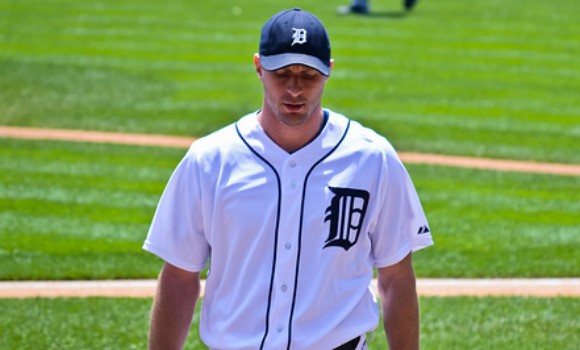The Washington Nationals signed Max Scherzer for seven years at the cheap price of $210 million.
No, that isn’t sarcasm: Scherzer’s $210 million deal is a bargain.
Before you tear your hair out by this seemingly illogical statement, you should know that the ace is deferring half his compensation, and will receive payouts of $15 million from 2015 to 2028. For those of you familiar with discount rates, that bit of information might explain my line of reasoning.
If not, here’s a brief explanation.
Money typically loses value over time due to inflation, and other factors. If you have $100 in the bank today, and the inflation rate is 5 percent, it would be worth $90.7 in two years.
Over at Fangraphs, Dave Cameron has a great explainer on why the structure of Scherzer’s contract is so sweet for the Nats, using a discount rate formula. Cameron points out that if the Cy Young award winner received payouts at flat or backloaded rates, his deal would be worth a lot more.
Here’s a graph from his story, which uses a seven percent discount rate:
Via Fangraphs.com
As you can see, Scherzer would earn approximately $30 million more if he received a flat paycheck of $30 million annually until 2021, and about $27 million more if his contract was backloaded like many Major Leaguers.
Instead, the 30-year-old is only earning $131,182,020 in discount-rated dollars. By comparison, Jon Lester — another high-profile pitcher who received a massive deal this off season — is making $121,373,821 in Net Present Value, $10 million less than Scherzer.
The kicker is Lester signed a seven-year $155 million contract (with a $10 million buyout option in 2021), so the former Detroit Tiger’s deal might seem much sweeter on first glance. But their NPV equivalent salaries aren’t that different.
Still with me? Okay. I expanded on Cameron’s calculations and determined how Scherzer’s contract stacks up to other star pitchers with comparable salaries.
Last year, Clayton Kershaw (the reigning NL Cy Young winner) and Masahiro Tanaka signed huge seven-year deals with their respective teams, the Los Angeles Dodgers and the New York Yankees. Kershaw bartered for $220 million, Tanaka $155 million. And given the relatively flat structures of Kershaw and Tanaka’s contracts, their deals are much sweeter than Scherzer’s.
Here’s how they shape up in terms of NPV:
• Kershaw (2014-20, $220 million): $168.47 million
• Tanaka (2014-20, $155 million): $126.87 million
In other words, Kershaw is worth approximately $30 million more than Scherzer, and Tanaka $4 million less.
Kershaw’s higher value shouldn’t come as a surprise, since he’s only 26 years old and is just coming into his prime years, while Scherzer is about to be on the wrong side of 30. But Tanaka’s NPV equivalent salary might come as a shock to some, especially considering 2014 was the righty’s first season in MLB.
Tanaka is also 26 years old and plays for the Yankees — who have a reputation for throwing money at their problems — so that could be why his deal is worth so much.
In the end, age might best explain why these four talented players are valued so differently. After Justin Verlander, 31, regressed significantly last season following a record (flat payout) deal with the Tigers in 2013, teams are rightfully squeamish about dishing out favorably-structured contracts to players at or north of 30.
That being said, Scherzer is still the second-highest paid pitcher on paper, and has a good shot at competing for a World Series title with the Nats. If that’s not cause for celebration, I don’t know what is.
STORY IDEAS
Basic principles of sports contracts











